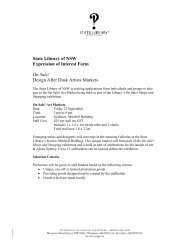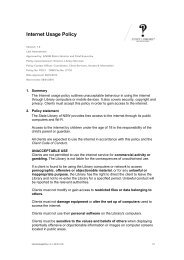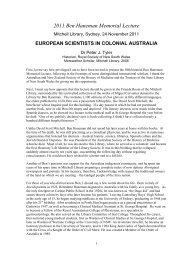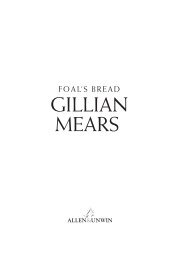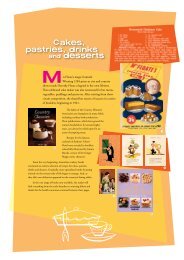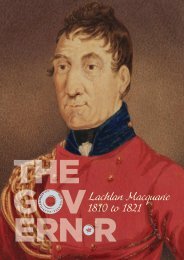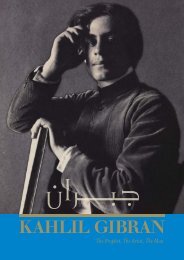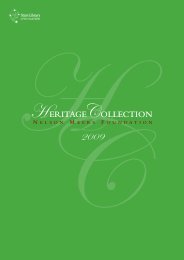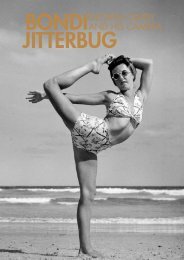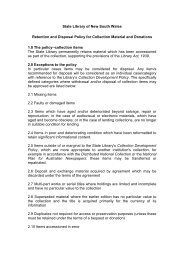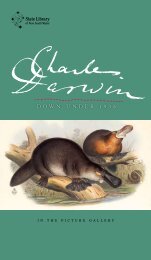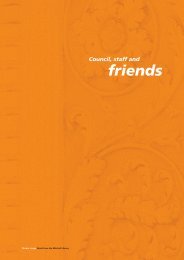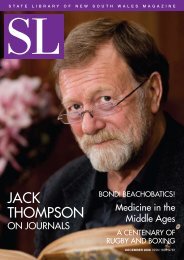John Lewin Primary Education Kit - State Library of New South Wales
John Lewin Primary Education Kit - State Library of New South Wales
John Lewin Primary Education Kit - State Library of New South Wales
Create successful ePaper yourself
Turn your PDF publications into a flip-book with our unique Google optimized e-Paper software.
<strong>Primary</strong> education kit<br />
A free exhibition at the<br />
<strong>State</strong> <strong>Library</strong> <strong>of</strong> NSW<br />
5 March to 27 May 2012
Introduction<br />
<strong>John</strong> William <strong>Lewin</strong> (1770 - 1819) was Australia’s first free<br />
pr<strong>of</strong>essional artist, emigrating from England to Australia in 1800.<br />
<strong>Lewin</strong> was also Australia’s first printmaker and the first person to<br />
publish an illustrated book in the colony, Birds <strong>of</strong> <strong>New</strong> <strong>South</strong> <strong>Wales</strong><br />
(1813).<br />
In his new home <strong>of</strong> Sydney, <strong>Lewin</strong> focused on collecting specimens<br />
and producing naturalist art for publication. His artworks include<br />
etchings, watercolours and oil paintings which describe the flora, fauna<br />
and landforms <strong>of</strong> Australia. He learnt his painting skills from his father,<br />
William <strong>Lewin</strong> (1747 - 1796), an English pattern maker and natural<br />
history painter. <strong>John</strong>, along with his other siblings, assisted his father in<br />
producing the illustrated publication Birds <strong>of</strong> Great Britain (1789).<br />
<strong>John</strong> <strong>Lewin</strong>’s significance as an artist is primarily due to his innovative<br />
style <strong>of</strong> naturalist painting. He began adding environmental context to<br />
his subjects; a dynamic change from traditional naturalist art. His<br />
enthusiasm for exploration and discovery in this field contributed to his<br />
success in documenting the unique Australian world with skill and<br />
fresh insight.<br />
<strong>Lewin</strong> had opportunities to work in various environments and met<br />
many challenges in his naturalist career including travelling to Tahiti in<br />
1801 where he helped defend missionaries threatened in a time <strong>of</strong> civil<br />
war.<br />
As a free settler with a desire to prosper in the Australian colony,<br />
<strong>Lewin</strong> was concerned with developing and maintaining a gentleman’s<br />
status throughout his life here. Being appointed Coroner for the Town<br />
<strong>of</strong> Sydney in 1810 gave him the benefit <strong>of</strong> sustainable income, housing<br />
and social standing to mix with fellow gentlemen and, in turn, patrons.<br />
<strong>Lewin</strong> also relied on government commissions for his work and some<br />
<strong>of</strong> his artworks even graced the walls <strong>of</strong> Government House. A<br />
significant event in <strong>Lewin</strong>’s career was his involvement with Governor<br />
Macquarie’s expedition to the desperately needed land beyond the Blue<br />
Mountains in 1815.<br />
<strong>Lewin</strong> considered Australia to be ‘the finest country in the world’. He<br />
typified the early Australian spirit <strong>of</strong> working hard to make a living in<br />
this land <strong>of</strong> opportunity. <strong>John</strong> <strong>Lewin</strong> passed away in 1819 but has left<br />
us a legacy <strong>of</strong> beautiful and significant images <strong>of</strong> Australia’s early<br />
history.<br />
2
Curriculum Links<br />
Referenced outcomes for Creative Arts: Visual Arts<br />
Stage 2 Stage 3<br />
Making VAS2.1 VAS3.1<br />
Represents the qualities <strong>of</strong> Investigates subject matter in an<br />
experiences and things that are attempt to represent likenesses <strong>of</strong><br />
interesting or beautiful by things in the world.<br />
choosing amongst aspects <strong>of</strong><br />
subject matter.<br />
VAS2.2<br />
Uses the forms to suggest the<br />
qualities <strong>of</strong> subject matter.<br />
VAS3.2<br />
Makes artworks for different<br />
audiences assembling materials in<br />
a variety <strong>of</strong> ways.<br />
Appreciating VAS2.3 VAS3.3<br />
Acknowledges that artists make Acknowledges that audiences<br />
artworks for different reasons and respond in different ways to<br />
that various interpretations are artworks and that there are<br />
possible.<br />
different opinions about the value<br />
<strong>of</strong> artworks.<br />
VAS2.4<br />
VAS3.4<br />
Identifies connections between Communicates about the ways in<br />
subject matter in artworks and which subject matter is<br />
what they refer to, and<br />
represented in artworks.<br />
appreciates the use <strong>of</strong> particular<br />
techniques.<br />
Referenced outcomes for Human Society and its Environment<br />
Change and<br />
Continuity<br />
Identities<br />
Cultural diversity<br />
Environments<br />
Patterns <strong>of</strong> place<br />
and location<br />
Stage 2<br />
Significant CCS2.1 CCS3.1<br />
events and Describes events and actions related Explains the significance <strong>of</strong> particular<br />
people to the British colonisation <strong>of</strong> people, groups, places, actions and<br />
Australia and assesses changes and events in the past in developing<br />
consequences.<br />
Australian identities and heritage.<br />
Cultures<br />
CUS2.3<br />
Explains how shared customs,<br />
practices, symbols, languages and<br />
traditions in communities contribute<br />
to Australian and community<br />
identities.<br />
CUS2.4<br />
Describes different viewpoints, ways<br />
<strong>of</strong> living, languages and belief<br />
systems in a variety <strong>of</strong> communities.<br />
ENS2.5<br />
Describes places in the local area<br />
and other parts <strong>of</strong> Australia and<br />
explains their significance.<br />
Stage 3<br />
CUS3.3<br />
Describes different cultural influences<br />
and their contribution to Australian<br />
identities.<br />
CUS3.4<br />
Examines how cultures change through<br />
interactions with other cultures and the<br />
environment.<br />
ENS3.5<br />
Demonstrates an understanding <strong>of</strong> the<br />
interconnectedness between Australia<br />
and global environments and how<br />
individuals and groups can act in an<br />
ecologically responsible manner.<br />
Relationships ENS2.6 ENS3.6<br />
with places Describes people’s interactions with Explains how various beliefs and<br />
environments and identifies practices influence the ways in which<br />
responsible ways <strong>of</strong> interacting with people interact with, change and value<br />
environments.<br />
their environment.<br />
<strong>Lewin</strong>: Wild Art Exhibition <strong>Primary</strong> <strong>Education</strong> <strong>Kit</strong><br />
© Community Learning Services, <strong>State</strong> <strong>Library</strong> <strong>of</strong> <strong>New</strong> <strong>South</strong> <strong>Wales</strong>
Outline <strong>of</strong> activities<br />
Visit the <strong>Lewin</strong>: Wild Art exhibition<br />
The <strong>State</strong> <strong>Library</strong> will display over 150 works by <strong>Lewin</strong> and other<br />
colonial artists sourced from our extensive collection and from<br />
institutions around the world. Practising contemporary artists will also<br />
be working in a studio space within the gallery. Students will have an<br />
opportunity to gain an insight into the artmaking process by observing<br />
and engaging with real artists. Artists work in the space from 10 am – 2<br />
pm weekdays excluding public holidays.<br />
Artist Dates in exhibition Website<br />
Paula Church<br />
5 March - 16 March<br />
Sally Gibbs 19 March - 30 March http://www.sallygibbs.com/<br />
Beverly Allen<br />
Deirdre Bean<br />
Rebecca Holmes<br />
Susannah Blaxill<br />
2 April – 13 April http://www.beverlyallen.com.au/<br />
16 April – 27 April http://www.botanicalartist.com.au/<br />
30 April – 11 May<br />
14 May – 25 May http://blaxill.com/<br />
Community Learning Services have prepared a range <strong>of</strong> activities for<br />
students to engage with the collection and develop skills in a number <strong>of</strong><br />
different subject areas. These include:<br />
free guided tours <strong>of</strong> the exhibition,<br />
art activities for all ages including drawing and watercolour<br />
painting from real animal specimens<br />
interactive investigative activities using iPads in the gallery<br />
space to document and present material on <strong>Lewin</strong>.<br />
Online resources – the next best thing!<br />
Check our website http://www.sl.nsw.gov.au/learning to see the<br />
resources we have produced for the <strong>Lewin</strong> exhibition.<br />
Resources include a PowerPoint presentation we recommend for use as<br />
a previsit activity, education kits and other multimedia resources.<br />
Video conferences<br />
Engage with an expert<br />
Richard Neville, curator <strong>of</strong> the <strong>Lewin</strong>: Wild Art exhibition and author <strong>of</strong><br />
Mr JW <strong>Lewin</strong>: Painter and Naturalist will be available for a video<br />
conference. Learn about <strong>John</strong> <strong>Lewin</strong>, the artist and patriotic Australian,<br />
from the Mitchell Librarian, a highly regarded expert in Australian<br />
colonial art.<br />
Watercolour workshop<br />
An experienced Visual Arts teacher will lead your students through a<br />
step-by-step process to complete an individual watercolour painting.<br />
Contact a member <strong>of</strong> the team on 9273 1778to find out about our video<br />
conferencing schedule.<br />
4
Crossing the Blue Mountains<br />
Despite his emphatic decision in 1803 never to go exploring again, by<br />
the 1810s <strong>Lewin</strong> was involved in a number <strong>of</strong> inland expeditions.<br />
By the early 1810s the colony was outgrowing the pastoral and<br />
agricultural capacity <strong>of</strong> the Sydney Basin. Pressure to find new sources<br />
<strong>of</strong> land encouraged Governor Macquarie to<br />
look beyond the natural boundary <strong>of</strong> the<br />
Blue Mountains.<br />
Landowners were similarly attracted to this<br />
possibility, and in May 1813 William<br />
Charles Wentworth, Gregory Blaxland and<br />
William Lawson were the first, <strong>of</strong>ficially at<br />
least, to chart a passage across the Blue<br />
Mountains. What they could see <strong>of</strong> the<br />
Western Plains delighted them, and<br />
Macquarie quickly asked Deputy Surveyor<br />
George William Evans to survey their route<br />
with a view to building a cart track across<br />
the mountains – essential infrastructure if<br />
the colony was to expand into these plains.<br />
Evans set <strong>of</strong>f on 19 November 1813, and Pitt’s Amphitheatre, 1815<br />
his reports <strong>of</strong> the plains around what is now<br />
known as Bathurst were glowing: an Eden waiting for occupation.<br />
When Governor Macquarie decided to travel over the mountains on the<br />
track that William Cox had scraped and blasted across them in the<br />
second half <strong>of</strong> 1814, he was full <strong>of</strong> anticipation about what he would<br />
find. The expedition set out from Emu Ford on 25 April 1815. In the<br />
<strong>Lewin</strong>: Wild Art Exhibition <strong>Primary</strong> <strong>Education</strong> <strong>Kit</strong><br />
© Community Learning Services, <strong>State</strong> <strong>Library</strong> <strong>of</strong> <strong>New</strong> <strong>South</strong> <strong>Wales</strong><br />
party were Elizabeth Macquarie, Sir <strong>John</strong> Jamieson, Captain Henry<br />
Antill <strong>of</strong> the 46th Regiment, Assistant Colonial Surgeon (and<br />
emancipist) Dr William Redfern, the colonial Secretary <strong>John</strong> Campbell,<br />
the Surveyor - General <strong>John</strong> Oxley, William Cox and ‘Painter and<br />
Naturalist’ Mr <strong>Lewin</strong> who, Antill noted in his journal, had volunteered<br />
to join the expedition.<br />
Antill made a private arrangement with<br />
<strong>Lewin</strong> to give him a copy <strong>of</strong> his journal in<br />
exchange for copies <strong>of</strong> <strong>Lewin</strong>’s<br />
watercolours. Antill keyed his journal to the<br />
watercolours. He listed 20 watercolours in<br />
his journal, although only 15 have survived.<br />
The entourage must have been an<br />
incongruous sight, with the Macquaries in a<br />
post-chaise – a four-wheel carriage with an<br />
enclosed cabin – bumping slowly along the<br />
newly cut, narrow track across the Blue<br />
Mountains, trailed by their entourage <strong>of</strong><br />
<strong>of</strong>ficials and some 40 servants.<br />
Macquarie was determined to enjoy what he<br />
was seeing, to celebrate the future <strong>of</strong> the colony, by embracing every<br />
opportunity to find beauty and value in the landscape. Even when the<br />
road became difficult and the land barren, the reward from its summit<br />
was ‘the most extensive and beautiful prospect’.<br />
(Richard Neville, 2012, extract from p.194 - 198)
Review questions<br />
What was the main motivation for exploring the land over the<br />
Blue Mountains?<br />
What was <strong>Lewin</strong>’s role on the expedition?<br />
How was the expedition documented and how would we<br />
document an expedition today?<br />
ACTIVITIES<br />
Use the following pages with focus questions and activities, as well as<br />
our interactive web resource in our Discover Collections to learn about<br />
the exploration to the west <strong>of</strong> Sydney by Governor Macquarie and his<br />
associates including <strong>John</strong> <strong>Lewin</strong>.<br />
Discover Collections - Macquarie's crossing<br />
http://www.sl.nsw.gov.au/discover_collections/history_nation/explorati<br />
on/macquarie/index.html<br />
Macquarie University <strong>Library</strong> and the <strong>State</strong> <strong>Library</strong> <strong>of</strong> <strong>New</strong> <strong>South</strong><br />
<strong>Wales</strong> – Macquarie’s journal<br />
http://www.library.mq.edu.au/all/journeys/1815/1815a.html<br />
<strong>John</strong> <strong>Lewin</strong><br />
Emu Ford<br />
1815<br />
Watercolour<br />
6
<strong>John</strong> <strong>Lewin</strong><br />
Cox’s Pass<br />
1815<br />
Watercolour<br />
<strong>Lewin</strong>’s pleasure in expedition life can be seen in Cox’s Pass. This<br />
watercolour depicts the expedition’s camp by Cox’s River on 29 and 30<br />
April 1815. The trees, the distant hill and the mess <strong>of</strong> the camp are<br />
again carefully observed. The reality <strong>of</strong> camp life is implied by the<br />
complete lack <strong>of</strong> interaction between the three figures. Most artists<br />
trying to make a picture out <strong>of</strong> this scene would have had the three<br />
figures involved with each other by theatrically pointing into the picture<br />
in an attempt to draw the viewer in.<br />
(Richard Neville, 2012, p.204)<br />
Focus questions<br />
<strong>Lewin</strong> captured a lot <strong>of</strong> detail in this work – what can you tell about<br />
colonial camp life from studying this painting? Compare this to<br />
camping in 2012.<br />
<strong>Lewin</strong> was one <strong>of</strong> more than 40 people on this expedition and his role<br />
was to document what they saw? What other roles would the<br />
expedition members have? What does the clothing tell us about the<br />
people on the expedition?<br />
Activity<br />
Write a journal entry or letter which outlines:<br />
your intended route<br />
goals for the expedition<br />
provisions<br />
companions<br />
hopes and fears for the expedition.<br />
<strong>Lewin</strong>: Wild Art Exhibition <strong>Primary</strong> <strong>Education</strong> <strong>Kit</strong><br />
© Community Learning Services, <strong>State</strong> <strong>Library</strong> <strong>of</strong> <strong>New</strong> <strong>South</strong> <strong>Wales</strong>
<strong>John</strong> <strong>Lewin</strong><br />
Cox’s Pass<br />
1815<br />
Watercolour<br />
8
<strong>John</strong> <strong>Lewin</strong><br />
The plains, Bathurst<br />
1815<br />
Watercolour<br />
The Bathurst Plains was the real target <strong>of</strong> Macquarie’s interest, and his<br />
euphoria over what he saw was visceral. In his private journal for 4<br />
May 1815 he wrote:<br />
The appearance <strong>of</strong> Bathurst Plains from the Depôt extending<br />
for many miles on both sides <strong>of</strong> the Macquarie River, and<br />
surrounded at a distance by fine verdant Hills, is truly grand,<br />
beautiful and interesting, forming one <strong>of</strong> the finest Landscapes<br />
I ever saw in any Country I have yet visited. The Soil is<br />
uncommonly good and fertile, fit for every purpose <strong>of</strong><br />
Cultivation and Pasture, being extremely well watered, and<br />
thinly wooded.<br />
The plains, Bathurst represents the success <strong>of</strong> occupation, <strong>of</strong> the dawn<br />
<strong>of</strong> British control over these lands <strong>of</strong> ‘milk and honey’, as Barron Field<br />
described them. The symbolism ran deep: Antill was deeply moved by<br />
the ceremony naming Bathurst on 7 May, and inspired to contemplate a<br />
future time ‘when a flourishing town may arise on the very spot we are<br />
now occupying …’<br />
(Richard Neville, 2012, p.198 - 205)<br />
Focus Questions<br />
How does this watercolour illustrate the success <strong>of</strong> the expedition?<br />
What features can you see that would make this land valuable to the<br />
English colony?<br />
Macquarie wrote in his account <strong>of</strong> the expedition (published in the<br />
Sydney Gazette on 10 June 1815),<br />
It is impossible to behold this grand scene without a feeling <strong>of</strong><br />
admiration and surprise, whilst the silence and solitude which<br />
reign in a space <strong>of</strong> such extent and beauty as seems designed by<br />
Nature for the occupancy and comfort <strong>of</strong> Man …<br />
Was this land actually free to claim? Who is missing from this scene?<br />
Activity<br />
Where would you position a town in this scene? Why?<br />
What difficulties would early settlers have faced in this environment?<br />
Make a list <strong>of</strong> the features your town would need.<br />
Choose a name for your town.<br />
<strong>Lewin</strong>: Wild Art Exhibition <strong>Primary</strong> <strong>Education</strong> <strong>Kit</strong><br />
© Community Learning Services, <strong>State</strong> <strong>Library</strong> <strong>of</strong> <strong>New</strong> <strong>South</strong> <strong>Wales</strong>
<strong>John</strong> W. <strong>Lewin</strong><br />
The plains, Bathurst<br />
1815 <br />
Watercolour<br />
10
<strong>John</strong> <strong>Lewin</strong><br />
Yango Mungo Y’eyango<br />
1815<br />
Watercolour<br />
A third, small monochrome wash drawing, Yango Mungo Y’eyango, is<br />
<strong>of</strong> a Wiradjuri man, said to be taken ‘from the life, on Bathurst Plains’.<br />
It may be one <strong>of</strong> the missing Aboriginal portraits, however, it does not<br />
agree with the descriptions Antill provides <strong>of</strong> the Aboriginal people<br />
supposedly illustrated. The drawing does, however, depict the possum<br />
cloaks described by Antill on 4 May: ‘manufacturing themselves cloaks<br />
<strong>of</strong> skins, very neatly sewed together by the sinews <strong>of</strong> kangaroos and<br />
emue, and carved on the inside with a variety <strong>of</strong> figures’.<br />
(Richard Neville, 2012, p. 209 - 211)<br />
Focus questions<br />
What materials might Aboriginal people use for clothing? How do you<br />
think this was seen by the British?<br />
Do you think Yango Mungo Y’eyango is posing for <strong>Lewin</strong>? What does<br />
this tell us about the relationship between the artist and the Aboriginal<br />
man?<br />
Does this painting represent a positive or negative view <strong>of</strong> Aboriginal<br />
people?<br />
Activity<br />
Imagine you are Yango Mungo Y’eyango from the Wiradjuri nation.<br />
Write a short conversation that might have taken place between you and<br />
<strong>John</strong> <strong>Lewin</strong> in 1815. What are some things you would ask or talk about<br />
with these new people? What might <strong>Lewin</strong>’s responses have been and<br />
what do you think he was interested in?<br />
<strong>Lewin</strong>: Wild Art Exhibition <strong>Primary</strong> <strong>Education</strong> <strong>Kit</strong><br />
© Community Learning Services, <strong>State</strong> <strong>Library</strong> <strong>of</strong> <strong>New</strong> <strong>South</strong> <strong>Wales</strong>
<strong>John</strong> W. <strong>Lewin</strong><br />
Yango Mungo Y’eyango<br />
1815<br />
Watercolour<br />
12
A new species<br />
When <strong>John</strong> <strong>Lewin</strong> came to Australia he came face to face with many<br />
previously undocumented species <strong>of</strong> plants and animals. Can you<br />
imagine the excitement <strong>of</strong> finding a new creature, studying it in its<br />
habitat and making a picture <strong>of</strong> it to show the rest <strong>of</strong> the world?<br />
You are going to create a painting <strong>of</strong> a new species <strong>of</strong> butterfly.<br />
Equipment needed<br />
A3 or A4 cartridge paper<br />
Oil pastels (wax crayons or candles will work too)<br />
Watercolour paints (watered down acrylic paints work too)<br />
Paintbrushes<br />
Water in containers<br />
Step 1 – Draw your specimen<br />
Using a light coloured wax crayon or candle, draw the outline <strong>of</strong> a<br />
butterfly on your cartridge paper. Butterflies have a long thin body, 2<br />
antennae and 4 large triangular shaped wings which you can alter to<br />
define your new species.<br />
Then draw interesting mirrored patterns on the wings <strong>of</strong> your specimen.<br />
You may wish to draw multiple smaller specimens on your paper or<br />
one large detailed butterfly.<br />
<strong>Lewin</strong>: Wild Art Exhibition <strong>Primary</strong> <strong>Education</strong> <strong>Kit</strong><br />
© Community Learning Services, <strong>State</strong> <strong>Library</strong> <strong>of</strong> <strong>New</strong> <strong>South</strong> <strong>Wales</strong>
Step 2 – Adding colour<br />
Mix up a number <strong>of</strong> coloured watercolour paints to use for each<br />
butterfly. You may wish to use many colours or just a few.<br />
Paint areas <strong>of</strong> the wings in different colours but make sure they are<br />
mirrored on each side. The oil pastel drawing should help keep your<br />
colours where you want them. Paint the body as well.<br />
Step 3 – Background<br />
Mix up two colours for your background (use colours different from<br />
your butterfly to create contrast).<br />
Wet your paper lightly in the background areas. Use the watercolour<br />
colours and daub parts <strong>of</strong> the background with each paint to create a<br />
mottled effect. The two paints should blend together in some areas to<br />
give a s<strong>of</strong>t appearance.<br />
Let your work dry and then write the name <strong>of</strong> your new specimen down<br />
the bottom.<br />
Speckled wing butterfly<br />
14
A bird, a bug and something bigger<br />
<strong>Lewin</strong> was a skilled illustrator. Use these techniques to draw an animal<br />
<strong>of</strong> your own choice.<br />
Basic shapes<br />
Look at these basic shapes. These are the building blocks <strong>of</strong> our<br />
drawing. If you can draw these confidently you will be able to easily<br />
construct your animal or whatever subject you are drawing.<br />
<strong>John</strong> W. <strong>Lewin</strong><br />
The ground parrot <strong>of</strong><br />
NSW c.1809<br />
Watercolour<br />
When making a drawing <strong>of</strong> anything, you may find it useful to break<br />
your drawing down into three simple steps<br />
1. Sketch basic shapes<br />
2. Create outlines<br />
3. Add details and texture<br />
Look at your subject. What basic shapes make up the whole shape <strong>of</strong><br />
your subject? Draw them lightly. Look at the example <strong>of</strong> the ground<br />
parrot painted by <strong>John</strong> <strong>Lewin</strong>. The basic shapes are overlayed so you<br />
can see the structure that makes up this specific example.<br />
But above all be observant and look at your subject. Study it before<br />
you draw it and while you draw it.<br />
<strong>Lewin</strong>: Wild Art Exhibition <strong>Primary</strong> <strong>Education</strong> <strong>Kit</strong><br />
© Community Learning Services, <strong>State</strong> <strong>Library</strong> <strong>of</strong> <strong>New</strong> <strong>South</strong> <strong>Wales</strong>
Create Outlines<br />
Now you need to develop your structure and refine the edges <strong>of</strong> your<br />
drawing.<br />
Study your subject again and draw a more accurate line around the<br />
edges <strong>of</strong> your image using the basic shapes to guide you.<br />
Erase unnecessary parts <strong>of</strong> your structural drawing.<br />
Your drawing should now have a refined outline similar to below.<br />
16
Add details and texture<br />
Details help describe your subject’s finer features. By careful<br />
observation you can work on one area at a time to develop the finer<br />
qualities <strong>of</strong> your drawing.<br />
Add a background like <strong>John</strong> <strong>Lewin</strong> did to complete your drawing.<br />
Use a sharp pencil to add feathers, scales, fur or skin. Some areas<br />
might be glossy like eyes, look for reflections and leave those areas<br />
white. Turn your pencil on its side and shade areas for shadows. Add<br />
colour if you desire.<br />
Refer to the chart below to see how to create a variety <strong>of</strong> descriptive<br />
textures.<br />
<strong>Lewin</strong>: Wild Art Exhibition <strong>Primary</strong> <strong>Education</strong> <strong>Kit</strong><br />
© Community Learning Services, <strong>State</strong> <strong>Library</strong> <strong>of</strong> <strong>New</strong> <strong>South</strong> <strong>Wales</strong>
Drawing Textures<br />
Fur<br />
Scales<br />
Feathers<br />
18



